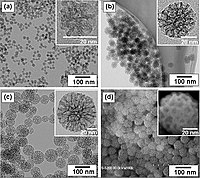
Photo from wikipedia
The 27-mer DNA aptamer for adenosine and ATP is a popular model system for designing biosensors. Various strategies have been reported for label-free colorimetric detection using gold nanoparticles (AuNPs). It… Click to show full abstract
The 27-mer DNA aptamer for adenosine and ATP is a popular model system for designing biosensors. Various strategies have been reported for label-free colorimetric detection using gold nanoparticles (AuNPs). It is generally accepted that free aptamers can protect AuNPs against salt-induced aggregation, while target bound aptamers cannot. However, these studies only considered the aptamer binding to its target, and the adsorption of the aptamer on AuNPs, but none considered the adsorption of target molecules by AuNPs. We herein report that the adsorption of adenosine destabilized citrate-capped AuNPs with an apparent Kd of just 7.7 μM adenosine, while ATP stabilized the AuNPs due to the negative charges from the triphosphate group. The adsorbed ATP inhibited the adsorption of DNA. Using the aptamer and a non-binding mutant, ATP and GTP had the same colorimetric response, and so did adenosine and guanosine, regardless of the DNA sequence, indicating that the color change mainly reflected the adsorption of the nucleosides and nucleotides instead of aptamer binding. The related literature examples using this aptamer were classified into three types and individually analyzed, where the reported color changes can all be explained by the adsorption of target analytes.
Journal Title: ACS sensors
Year Published: 2020
Link to full text (if available)
Share on Social Media: Sign Up to like & get
recommendations!